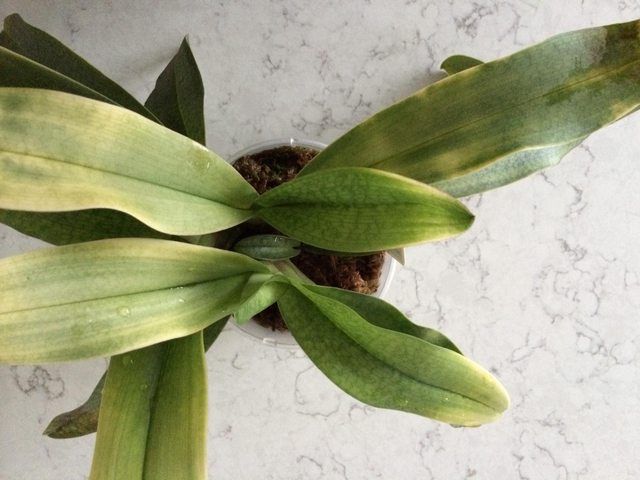Happypaphy7
Paphlover
Did the leaf before this one start this way?
It's been growing this way for a little over one year.

Did the leaf before this one start this way?
The order of antagonism is NH4>K>Mg>Ca, and until you get to very low ammonia and K (like <1ppm N and 2-5 ppm K) the plants selectively pull up the more antagonistic items. I'm not sure what you consider "acceptable ranges" but ammonia and K is rare in the environment at more than a ppm or two.
You might want to get a pH strip and see if you can get a pH in contact with the roots (not the substrate). If the pH at the roots is > 6.5~7 you are likely seeing a N deficiency, and a dash of ammonia would help. Sue Bottom
wrote a nice article in August issue of Orchids that highlights the forms of N and which way it drives the rhyzosphere pH.
What the plant would do is start pumping out more citric and malic acid to lower the pH at the root down to ~ 5.8s.u. (which is where I started adding lemon juice to support what the plant would normally be doing anyway).
It is around 5.5-6.0
Not so much between Ca and Mg if they are within the ratio a plant prefers. I think he uses a balance fert so his K is pretty high already and i believe he will need to overcome that ratio between K and Ca. And this thing about cation ratio is very species specific. im only thinking about this specific plantThe order of antagonism is NH4>K>Mg>Ca, and until you get to very low ammonia and K (like <1ppm N and 2-5 ppm K) the plants selectively pull up the more antagonistic items. I'm not sure what you consider "acceptable ranges" but ammonia and K is rare in the environment at more than a ppm or two.
You might want to get a pH strip and see if you can get a pH in contact with the roots (not the substrate). If the pH at the roots is > 6.5~7 you are likely seeing a N deficiency, and a dash of ammonia would help. Sue Bottom
wrote a nice article in August issue of Orchids that highlights the forms of N and which way it drives the rhyzosphere pH.
What the plant would do is start pumping out more citric and malic acid to lower the pH at the root down to ~ 5.8s.u. (which is where I started adding lemon juice to support what the plant would normally be doing anyway).
I normally use balanced fertilizer with both Ca and Mg included.
On this plant, I used CalMag alone seperatley, and Epsom Salt separately.
I don't think it is deficiency.
So you have covered that part. I was just thinking that you have lots of K in your media and so you msy need more Ca to evercome that.
Btw, what I mean about Ca supplement doesnt mean a plant needs extra Ca. Some species just is not as efficient in taking this cation and so you provide more. It seems like K is easily absorbed while the availabilty is low.
I have a few parvi hybrid and just like the others here experienced, the newest leaf is prone to seem like black rot. I remember some catts I hsve before showed the same syptoms and it wasnt rot but Ca deficiency.
I did the same thing on these plants and the new leaves now show no black lesions.
This Ca supply is sometimes tricky. My experience is that its not as effective if mixed with urea and sulphur although i didnt see any precipation. I was struggling then. Alil bit of ammomium seems to work better.
Sent from my HTC One using Tapatalk
I've seen your other plants HP. This has nothing to do with nutrients.

Enter your email address to join: